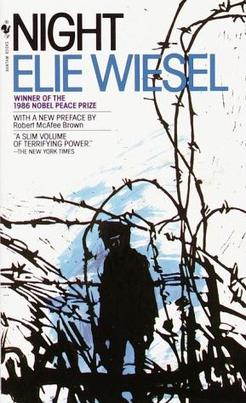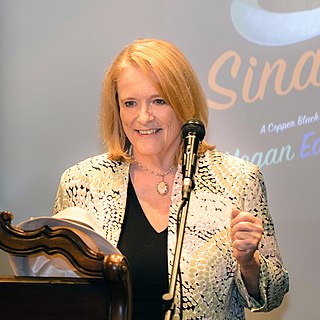
Night is a 1960 memoir by Elie Wiesel based on his Holocaust experiences with his father in the Nazi German concentration camps at Auschwitz and Buchenwald in 1944–1945, toward the end of the Second World War in Europe. In just over 100 pages of sparse and fragmented narrative, Wiesel writes about his loss of faith and increasing disgust with humanity, recounting his experiences from the Nazi-established ghettos in his hometown of Sighet, Romania, to his migration through multiple concentration camps. The typical parent–child relationship is inverted as his father dwindled in the camps to a helpless state while Wiesel himself became his teenaged caregiver. His father died in January 1945, taken to the crematory after deteriorating from dysentery and a beating while Wiesel lay silently on the bunk above him for fear of being beaten too. The memoir ends shortly after the United States Army liberated Buchenwald in April 1945.

Yisrael (Israel) Meir Lau is a Holocaust survivor who served as the Ashkenazi Chief Rabbi of Israel from 1993 to 2003. He was previously Chief Rabbi of Tel Aviv, Israel. After his tenure as chief rabbi, he was appointed chairman of Yad Vashem.

Slutsk is a town in Minsk Region, Belarus. It serves as the administrative center of Slutsk District, and is located on the Sluch River 105 km (65 mi) south of the capital Minsk. As of 2024, it has a population of 60,056.

The Schindlerjuden, literally translated from German as "Schindler Jews", were a group of roughly 1,200 Jews saved by Oskar Schindler during the Holocaust. They survived the years of the Nazi regime primarily through the intervention of Schindler, who afforded them protected status as industrial workers at his enamelware factory in Kraków, capital of the General Government, and after 1944, in an armaments factory in occupied Czechoslovakia. There, they avoided being sent to death camps and survived the genocide. Schindler expended his personal fortune made as an industrialist to save the Schindlerjuden.

The Devil's Arithmetic is a historical fiction time slip novel written by American author Jane Yolen and published in 1988. The book is about Hannah Stern, a Jewish girl who lives in New Rochelle, New York, and is sent back in time to experience the Holocaust. During a Passover Seder, Hannah is transported back in time to 1941 Poland, during World War II, where she is sent to a concentration camp and learns the importance of knowing about the past.
Feldheim Publishers is an American Orthodox Jewish publisher of Torah books and literature. Its extensive catalog of titles includes books on Jewish law, Torah, Talmud, Jewish lifestyle, Shabbat and Jewish holidays, Jewish history, biography, and kosher cookbooks. It also publishes children's books. The company's headquarters is located in New York, with publishing and sales divisions in Jerusalem. Its president is Yitzchak Feldheim.

The Boy in the Striped Pyjamas is a 2006 historical fiction novel by Irish novelist John Boyne. The plot concerns a German boy named Bruno whose father is the commandant of Auschwitz and Bruno's friendship with a Jewish detainee named Shmuel.
Hanoch Teller is an Orthodox Jewish rabbi, author, lecturer, and producer who popularized the Jewish literary genre of true, contemporary stories to convey inspirational and ethical themes. Author of 28 books, Teller is also a tour guide in Jerusalem, Israel.

Megan Frances Edwards is an American writer and editor.

Arzei Habira is a Haredi neighborhood in Jerusalem. It is bordered by Ma'alot Dafna to the north, Shmuel HaNavi to the west, Beit Yisrael to the south, and Road 1 and Sheikh Jarrah to the east.

Lee Klancher's career encompasses more than 30 years of publishing stories. As an editor and publisher, he has overseen the development of some of the best-selling books in the transportation niche. A prolific author and photographer, Lee has contributed words and images to more than 30 books as well as dozens of national magazines.
Hanoch Hecht, also known as the 6 Minute Rabbi, is the spiritual leader of the Rhinebeck Jewish in Rhinebeck, NY and director of Chabad of Dutchess County. He is the son of Shea Hecht and the grandson of the late Jacob J. Hecht.

The Holocaust in the Independent State of Croatia involved the genocide of Jews, Serbs and Romani within the Independent State of Croatia, a fascist puppet state that existed during World War II, led by the Ustaše regime, which ruled an occupied area of Yugoslavia including most of the territory of modern-day Croatia, the whole of modern-day Bosnia and Herzegovina and the eastern part of Syrmia (Serbia). Of the 39,000 Jews who lived in the NDH in 1941, the United States Holocaust Memorial Museum states that more than 30,000 were murdered. Of these, 6,200 were shipped to Nazi Germany and the rest of them were murdered in the NDH, the vast majority in Ustaše-run concentration camps, such as Jasenovac. The Ustaše were the only quisling forces in Yugoslavia who operated their own extermination camps for the purpose of murdering Jews and members of other ethnic groups.
Sandy Eisenberg Sasso is the first woman to have been ordained a rabbi in Reconstructionist Judaism. She was ordained by the Reconstructionist Rabbinical College in Philadelphia, on May 19, 1974. She is also the author of many children's books on religious topics.
Rabbi Nochum Partzovitz was a rabbi and Rosh Yeshiva of Yeshivas Mir, the largest Yeshiva in the word at the time. He is known worldwide for erudite explanations of Talmudic topics.
The Helen and Stan Vine Canadian Jewish Book Awards were a Canadian program of literary awards, managed, produced and presented annually by the Koffler Centre of the Arts to works judged to be the year's best works of literature by Jewish Canadian writers or on Jewish cultural and historical topics.

In the best-known photograph taken during the 1943 Warsaw Ghetto Uprising, a boy holds his hands over his head while SS-Rottenführer Josef Blösche points a submachine gun in his direction. The boy and others hid in a bunker during the final liquidation of the ghetto, but they were caught and forced out by German troops. After the photograph was taken, all of the Jews in the photograph were marched to the Umschlagplatz and deported to Majdanek extermination camp or Treblinka. The exact location and the photographer are not known, and Blösche is the only person in the photograph who can be identified with certainty. The image is one of the most famous photographs of the Holocaust, and the boy came to represent children in the Holocaust, as well as all Jewish victims.

Mesivta Rabsa Eitz Chaim DiSlutsk, colloquially known as the Slutsk-Kletsk Yeshivah was an Orthodox Jewish yeshiva in Europe, founded in Slutsk, then part of the Russian Empire, and later moved to Kletsk in the Second Polish Republic, in 1897. The yeshiva was founded by the Ridvaz and famously led by Rabbi Isser Zalman Meltzer and Rabbi Aharon Kotler.












